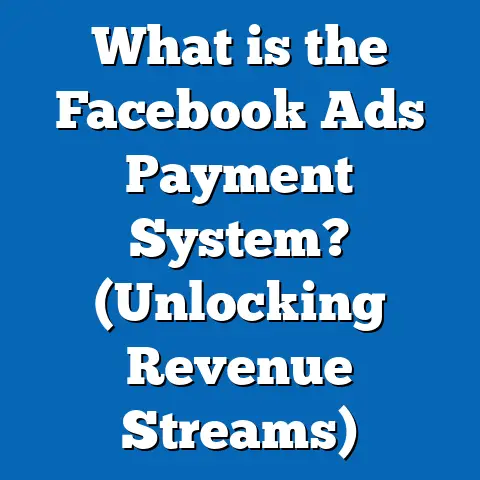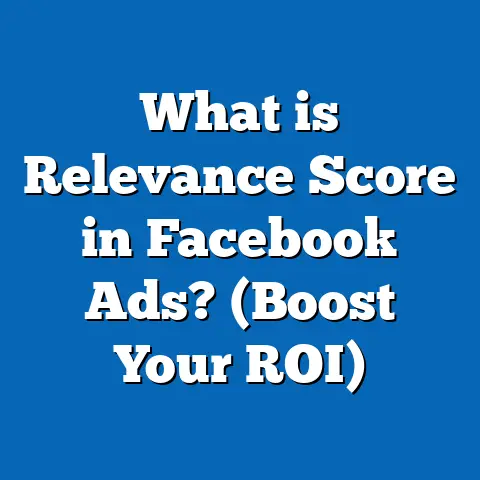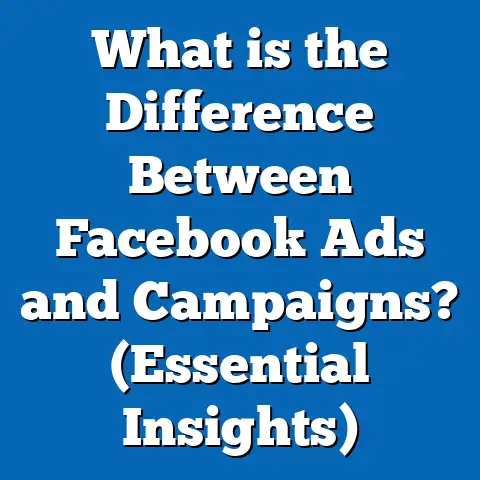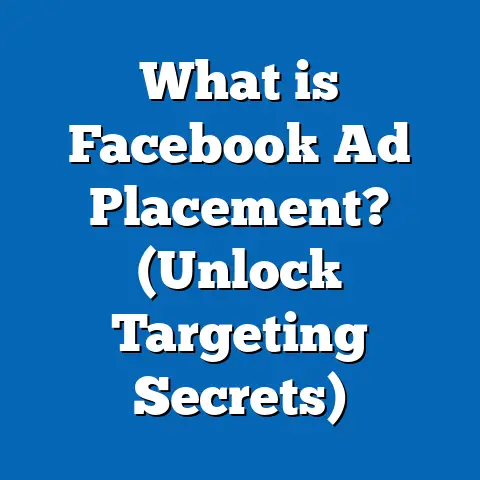What is Sharing Ad Revenue on Facebook? (Unlocking Profit Potential)
What is Sharing Ad Revenue on Facebook? (Unlocking Profit Potential)
Introduction: Tapping into Seasonal Trends to Maximize Facebook Ad Revenue
As businesses prepare for peak seasons like Black Friday, Christmas, and New Year, marketing budgets swell and competition for audience attention intensifies. Facebook, with its colossal global presence, becomes a prime battleground for brands competing to capture consumer interest. For marketers and business owners, understanding how to unlock new revenue streams is vital—not just from direct sales but from the platform itself.
One of the most promising opportunities lies in Facebook’s ad revenue sharing model. This allows content creators and businesses to earn a share of the advertising money generated through their content. Leveraging this model effectively means turning Facebook from simply a marketing expense into a revenue-generating asset.
This article will walk you through every aspect of Facebook’s ad revenue sharing—from basics to advanced tactics—helping you maximize your profit potential during seasonal peaks and beyond.
Understanding Facebook’s Ad Revenue Sharing Model
What Is Ad Revenue Sharing?
Ad revenue sharing on Facebook is a monetization program where Facebook shares part of the advertising income generated from ads displayed on or alongside user-generated content with the creators or page owners. This mechanism incentivizes content creation and engagement by directly rewarding those who contribute valuable content.
The main focus is on video content — including live streams, recorded videos, and short-form videos (Reels) — because video ads have proven highly effective at capturing user attention and generating revenue.
Why Is Facebook Sharing Ad Revenue?
- Content Drives Platform Value: User-generated content keeps users engaged and returning to the platform.
- Monetization Incentive: Sharing ad revenue motivates creators to produce high-quality, engaging content.
- Competitive Positioning: To compete with YouTube, TikTok, and other platforms offering creator monetization, Facebook must offer lucrative options.
How Does Facebook’s Revenue Sharing Work?
- Ad Placement: Ads appear before, during, or after videos (in-stream ads), between Reels, or as banner ads on content pages.
- Revenue Split: Typically, creators earn about 55% of the ad revenue generated by these ads.
- Eligibility Requirements: Creators must meet thresholds related to followers, video views, and content policies.
- Payout Process: Earnings accumulate in Creator Studio or Business Manager accounts and are paid monthly once a minimum payout threshold is met.
The Data Behind Facebook’s Ad Revenue Program
Massive Video Consumption Drives Monetization
Facebook video consumption continues to grow rapidly:
- Over 2 billion daily video views occur on Facebook globally.
- Video engagement rates increased by 20% year-over-year in 2023, according to third-party analytics.
- Advertisers spend over $30 billion annually on Facebook video ads alone.
Revenue Growth Trends
- Facebook’s total ad revenue hit $150 billion in 2023, with video ads contributing an estimated 30%.
- Monetized video creators saw an average monthly earning increase of 25% in 2023, driven by in-stream ads and Reels monetization.
Audience Demographics for Video Ads
- The 18-34 age group watches 60% more video content on Facebook compared to older demographics.
- Mobile users account for 75% of all video views, emphasizing the importance of mobile-optimized content.
Types of Ad Revenue Sharing on Facebook
1. In-Stream Video Ads
In-stream ads are the core monetization method for video creators:
- Ads appear between Reels as short, skippable video clips.
- Creators can earn based on views and engagement metrics.
Reels represent a key growth area as short-form video dominates social media consumption.
3. Fan Subscriptions & Stars
While not strictly ad revenue sharing, these features allow additional monetization:
- Fans can subscribe monthly to support creators.
- Stars are virtual gifts purchased by fans during live streams.
These complement ad revenue by providing direct financial support.
Eligibility Criteria and How to Qualify
Basic Requirements
To participate in Facebook’s ad revenue sharing programs, creators must meet:
| Criteria | Details |
|---|---|
| Followers | Minimum 10,000 followers on the Facebook Page |
| Video Views | At least 600,000 minutes viewed over last 60 days on eligible videos |
| Content Compliance | Must abide by Facebook’s Monetization Policies |
| Location | Must be in supported countries (40+ countries) |
Additional Considerations
- Pages must have a minimum of five or more active video uploads.
- Videos must be original (not reposted from other sources).
- No history of severe policy violations.
Step-by-Step Guide to Applying for Ad Revenue Sharing
- Set Up a Facebook Page or Creator Profile: Ensure your page is active with original video content.
- Meet Follower and View Thresholds: Focus on growing followers and watch time via consistent posting.
- Review Monetization Policies: Familiarize yourself with Facebook’s community standards and monetization rules.
- Apply via Creator Studio or Business Manager: Submit your page for review under the “Monetization” tab.
- Wait for Approval: Takes approximately 1–2 weeks; monitor your email for updates.
- Enable In-Stream Ads/Reels Monetization: Once approved, enable monetization features on eligible videos.
Practical Examples and Case Studies
Case Study 1: Local Fitness Coach Monetizing Workout Videos
A fitness coach with a page of 15,000 followers started producing 10-minute workout tutorials three times weekly. After enabling in-stream ads:
- Earned $1,200 in ad revenue within three months.
- Increased average video watch time by 25%, boosting eligibility further.
- Used insights from Creator Studio to optimize posting times and content themes.
Case Study 2: Digital News Publisher Using Reels Ads
A regional news outlet produced daily news summaries as Reels (under 60 seconds). By integrating Reels ads:
- Achieved a 30% increase in total ad revenue within six months.
- Grew younger audience segment (18–24 years) by 40%.
- Leveraged trending hashtags to boost discoverability.
Case Study 3: E-commerce Brand Leveraging Multiple Monetization Streams
An online fashion retailer combined in-stream ads with fan subscriptions and direct product promotions:
- Monthly ad revenue from videos reached $2,500.
- Fan subscriptions added an extra $400 monthly.
- Integrated product tags in videos increased sales conversion by 15%.
Why Should Marketers and Business Owners Care?
Unlocking Multiple Benefits
- Diversify Income Sources
Ad revenue sharing supplements traditional sales or sponsored posts with passive income based on content performance.
- Increase Content Production Incentives
Monetization encourages regular posting of quality content that resonates with audiences.
- Boost Organic Reach
Facebook’s algorithm favors monetized content, often increasing organic visibility—a significant advantage for small businesses.
- Build Community and Loyalty
Through fan subscriptions and Stars, brands can foster closer relationships with their audiences.
Comparison With Other Platforms
| Platform | Revenue Share | Content Types Monetized | Eligibility | Key Advantage |
|---|---|---|---|---|
| ~55% | In-stream videos, Reels | 10k followers + 600k minutes viewed | Large global user base | |
| YouTube | ~55% | Videos | 1k subscribers + 4k hours watched | Mature ecosystem & search traffic |
| TikTok | Varies | Short-form videos | No strict follower threshold | Viral potential & fast growth |
| Limited rollout | IGTV Ads, Reels (pilot phase) | Currently limited | Cross-platform integration |
Facebook offers diverse formats but requires more stringent eligibility criteria compared to TikTok’s open access model.
Advanced Strategies for Maximizing Facebook Ad Revenue
1. Content Strategy Optimization
- Prioritize creating videos longer than three minutes to qualify for in-stream ads.
- Use storytelling techniques to maintain viewer retention through mid-roll ads.
- Experiment with live streams which can also include ads and Stars monetization.
2. Leverage Seasonal Trends
Tie content themes to relevant holidays and events (e.g., fitness challenges in January, gift guides in December).
Seasonal spikes can drive higher engagement and ad revenue.
3. Use Data Analytics Effectively
Regularly analyze:
- Video watch time trends
- Audience demographics
- Peak engagement hours
Adjust posting schedules and topics based on these insights.
4. Promote Cross-Promotion Within Facebook Ecosystem
Use Stories, Groups, and Events to cross-promote your monetized videos for broader reach.
Practical Tips for Content Creation That Drives Revenue
Best Practices for Videos Eligible for In-stream Ads
- Start videos with engaging hooks within the first few seconds.
- Maintain consistent branding visuals to increase recall.
- Use captions/subtitles since many users watch without sound.
- Avoid abrupt scene changes that could disrupt ad placement flow.
Optimizing Reels for Monetization
- Keep Reels short (15–30 seconds).
- Use trending sounds and hashtags to boost reach.
- Encourage interactions through calls-to-action (comments/shares).
Navigating Challenges & Risks in Facebook Ad Revenue Sharing
Algorithm Instability Can Impact Earnings
Sudden changes in Facebook’s feed algorithms may reduce organic reach and video views unexpectedly.
Mitigation Strategy: Diversify traffic sources; do not rely solely on Facebook organic reach.
Content Policy Violations Risk Demonetization
Strict enforcement means:
- Avoid copyrighted content unless you have rights.
- Stay clear of sensitive topics that violate community standards.
Payment Delays & Thresholds
Creators must accumulate a minimum balance (usually $100) before payment is processed monthly.
Plan cash flow accordingly if relying on this income stream.
Future Trends Shaping Facebook Ad Revenue Sharing
Growth of Short-Form Video Monetization
Facebook will likely expand Reels ad opportunities as short-form video consumption grows over 40% annually worldwide.
Artificial Intelligence Enhancing Ad Targeting
AI-driven personalized ads will improve CPM rates by delivering more relevant ads to users who engage with specific types of content.
Integration with E-commerce & Live Shopping
Facebook Shops combined with live streams featuring shoppable products will create hybrid revenue models combining direct sales with ad revenue.
Actionable Next Steps for Marketers and Business Owners
- Audit Your Current Video Content
Identify which videos already meet length and engagement criteria for monetization potential.
- Grow Your Audience
Focus on strategies like contests, collaborations, and paid promotions to hit follower thresholds quickly.
- Apply for Monetization Programs
Use Creator Studio to submit your page for review as soon as you meet eligibility requirements.
- Develop a Content Calendar
Plan consistent posting aligned with industry trends and seasonal spikes.
- Monitor Analytics Monthly
Adjust strategies based on performance metrics like watch time and revenue per video.
- Experiment with New Formats
Test Reels, live streams, and longer tutorials to diversify earnings.
Comprehensive Summary: Unlocking Your Profit Potential on Facebook Through Ad Revenue Sharing
Facebook’s ad revenue sharing program offers a compelling opportunity for marketers and business owners to add a significant income stream while growing their audience engagement. Understanding eligibility criteria, optimizing content strategy around video length and engagement, leveraging seasonal trends, and using data insights are critical steps toward maximizing earnings.
With over two billion daily video views and continuous improvements in monetization features — especially around Reels — now is the optimal time to integrate Facebook ad revenue sharing into your marketing strategy. Whether you manage a local business page or a large media outlet, unlocking this profit potential requires careful planning but offers substantial rewards when done right.
If you want me to create detailed templates for content calendars, analytics tracking sheets, or influencer collaboration guides tailored specifically for Facebook monetization strategies—just ask!




